This is not the first time that French billionaire François Pinault has called on the services of Tadao Ando. Twenty years ago, when the luxury-goods mogul was initially seeking to display his fabled collection of contemporary art in Paris, he had the Pritzker Prize winner design him a brand new museum on Boulogne-Billancourt’s Île Seguin, erstwhile site of the original Renault car factory. But after that project foundered on the rocks of bureaucratic sluggishness, Pinault turned his attention to Venice, where he commissioned Ando to convert the Palazzo Grassi and the Punta della Dogana into galleries. Now the tycoon has finally come home to roost with a new conversion project, bang in the French capital’s heart: the former Bourse de Commerce (commodities exchange), strategically located between the Louvre and the Centre Pompidou.
Pinault has a reputation for loyalty to trusted collaborators, and so it was that he commissioned Ando to design his new museum. But, since the Japanese architect is not qualified to practice in France, Pinault asked him to partner with young local firm NeM—Lucie Niney and Thibault Marca—who had previously worked for Pinault in Lens, France, where they realized a small artists-in-residence structure. Two more practices were hired for the job: the group setec bâtiment, a master in complex projects of this sort (its back catalogue includes the Fondation Louis Vuitton), who acted as team coordinator and architect of record, and heritage specialist Pierre-Antoine Gatier, since La Bourse is an important historic monument.
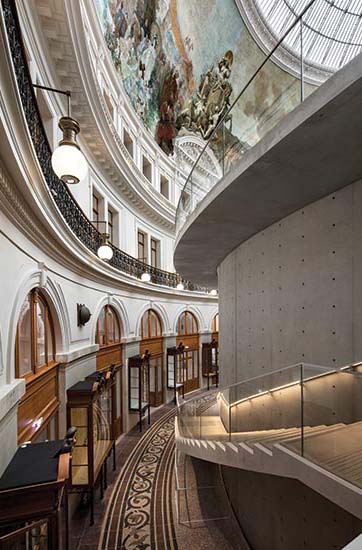
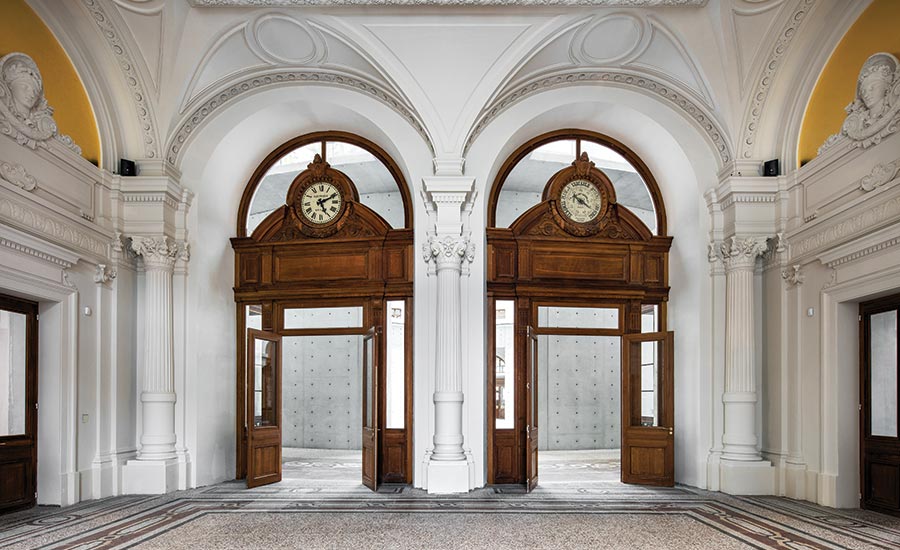
The cylinder’s concrete wall can be seen from the glass entrance doors. Photos © Patrick Tourneboeuf, click to enlarge.
The building stands on the site of a 16th-century royal palace, of which only a vestige now survives—the Colonne Médicis, a 102-foot-high Doric column that may have been used for astronomical observations. After the palace’s demolition in the mid-18th century, the site became home to the Halle au Blé, Paris’s corn exchange, designed by Nicolas Le Camus de Mézières and built in 1763–67. A circular stone edifice, it enclosed a large open-air court at its heart, which was later covered with a wooden dome. The dome burned in 1802, after which François-Joseph Bélanger erected a pioneering iron-framed replacement in 1806–11. Over the course of the 19th century, the Halle au Blé became too small for its original function, and, in 1885, work began to convert it into a commodities exchange. To do this, the architect Henri Blondel conserved both the courtyard wall of Le Camus de Mézières’s building and Bélanger’s dome, but demolished all the rest (apart from a double-revolution staircase), replacing it with a ring of office accommodation. He also modified the courtyard elevation and Bélanger’s dome, glazing the latter at its summit and facing its lower parts with slate, the inner surface thus obtained being decorated with a giant canvas depicting trade between the five continents. The transformation was completed in 1889, just in time for the Exposition Universelle of that year, which marked the centenary of the French Revolution.
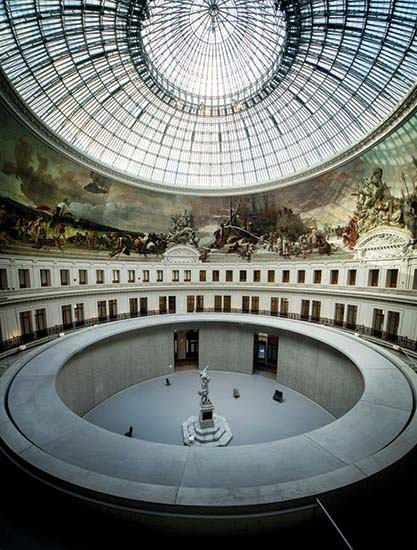
Ando and NeM collaborated on the design of the concrete insertion in the rotunda. Photo © Yuji Ono
This was the building that Ando was taken to see in 2015, after the City of Paris had begun negotiations to purchase it from the Chamber of Commerce and was brokering a 50-year lease with Pinault. As at the Gare d’Orsay 40 years before, the challenge was to fill a 19th-century glass-roofed void with something that would allow artworks to be displayed on and in it, but without that something altering the nature of the void too fundamentally. “I have consistently experimented with architecture inside architecture,” Ando told RECORD. “From Venice to Paris, I have inserted modern interventions into historic buildings. The new structure must be formidable enough to compete with a historical building’s overwhelming and powerful presence. I find this strength in the purity of primordial and Platonic geometries.” The geometry he used at the Bourse is, naturally enough, a cylinder, an old Ando trope (Paris already had one by him, the 1995 UNESCO meditation space), which he placed inside the rotunda under the dome. Realized in his trademark in situ–cast concrete, and pierced with three giant portals, it “allows us to create a calmer exhibition space [than provided by Blondel’s busy elevations],” explains Lucie Niney, “offering optimal conditions for the contemplation of artworks.” For Ando, it also evokes a building that strongly marked him as a young man: “I thought that the ethereal projections of sunlight, as at the Roman Pantheon, would reflect the changes in time and season in space, revealing the geometry and the expression of the concrete wall.”
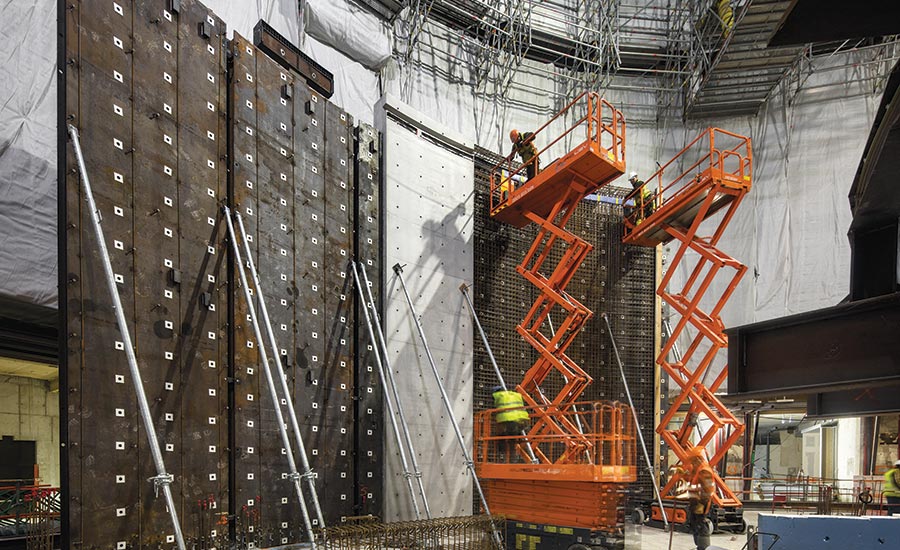
The hollow concrete wall panels were hung from a metal frame to avoid damaging the floor.
While the idea may sound compellingly simple, its realization was anything but. Firstly, Pinault was in a hurry: announced in April 2016, the museum was initially set to open in early 2019. Since purchase of the Bourse was not completed until 2017, preliminary design studies had to be undertaken before a building survey could be carried out. Ando had initially proposed a very tall, wide cylinder with a walkway two-thirds up projecting from its outer surface, at the level of the Bourse’s second story. Once the design team finally gained access to the site, they were able to build mockups, resulting in a radical modification of the initial intuition. “We insisted that, at the second level, you needed to keep the view open across the entire width of the Bourse,” says Niney. “Otherwise, the original perception of the space was entirely lost.” Ando was thus persuaded to lower his cylinder to the second-story level, as well as to leave a wider ring of space around it, again for better perception of the original building, but also so the ring could accommodate artworks (in the Bourse’s 19th-century vitrines, which he had initially planned to remove). Then there was the question of how to construct the cylinder. “Since the building is landmarked, we couldn’t demolish the rotunda’s floor to build a concrete wall,” explains Niney. “So we decided to pierce it at certain points with steel supports and to hang the concrete from a metal frame.” This rather unorthodox solution had two big advantages: reversibility—the cylinder can be more easily dismantled—and the fact that, because it is hollow, all the rotunda’s heating and ventilation and much of its lighting could be integrated into it, thereby relieving Blondel’s elevations of those functions. “Besides shortening the cylinder,” continues Niney, “the biggest change we proposed to Ando was redefining the nature of a concrete wall, which traditionally is solid. But we probably also had a false idea about his conception of concrete, since it turns out he has no fixed formulae. ‘Concrete is inexpensive and found everywhere,’ he told us; ‘that’s why I use it. As such, it’s a sort of non-material, a form of abstraction.’ ”
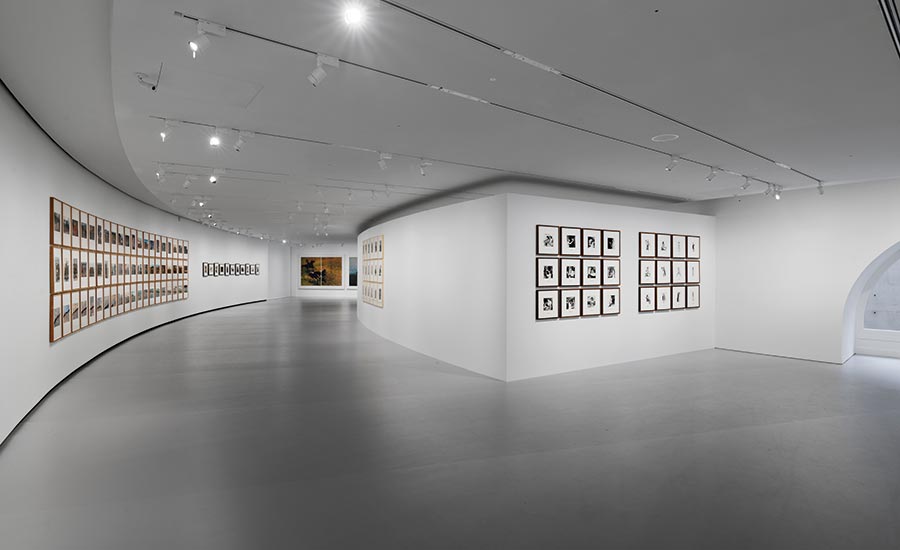
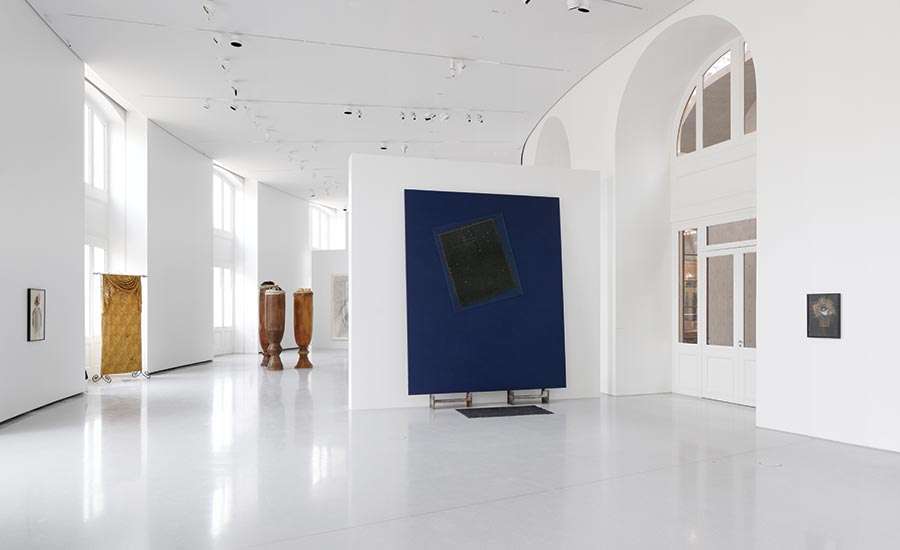
Galleries have access to daylight. Photos © Aurélien Mole
But to get concrete to that level of abstraction, it needs to be well made—if not, brute material reality may ruin the effect. “Mr. Pinault . . . was always strict and uncompromising in his approach, sometimes more so than me!” says Ando. “For example, he insisted on an almost perfect execution of the concrete walls.” Daniel Sancho, Pinault’s project leader, agrees: “Ando has never had concrete as beautiful as this—he says so himself!” Indeed all the detailing is highly soigné: the narrow gap left between the cylinder and its stair, for example, as well as that between Blondel’s facades and the footbridges leading off the cylinder’s walkway (“we insert but never touch,” says Niney); the stair and walkway handrails, for which NeM was inspired “by those Ando designed in his early houses,” more graceful than the guardrails in his more recent projects, they say; the shadow joint between the cylinder and the rotunda floor; or the transition as you descend the cylinder’s stair into the basement, where the illusion of continuity is maintained and upward sightlines skillfully handled. NeM sought a more matte concrete finish than Ando usually uses, “so that it would catch the light,” says Niney; artificial light rains down from the cylinder’s summit, thanks to a projecting “cornice,” which also serves to hide the sight of visitors on the walkway from those contemplating art within the cylinder. Left fully hollow for hanging works, Ando’s trademark tie-rod holes cadence the endless concrete expanse like a mammoth masonry pegboard.
Converting Blondel’s rings of offices into exhibition and other public spaces (including a top-floor restaurant) proved relatively straightforward, his use of a mezzanine meaning that double-height galleries could be obtained at grade level by removing the intermediary floor. Indeed, La Bourse enjoys the full range of display spaces, from the low-ceilinged and intimate (part of the mezzanine that was not removed) to the handsomely proportioned main galleries on the first and second levels (the latter achieved by removing part of the third level’s floor) and the monumental space inside the cylinder, suitable for very large-scale and special-commission works. All the above-grade galleries are naturally lit, the architects having prioritized views through the building from the rotunda out to the cityscape (there are blackout blinds if needed). The one windowless gallery is located in the basement, a black-box modular space for performances or video art. The basement also contains a 284-seat auditorium, occupying one half of the cylinder, that looks out through a wall of glazing “in the same spirit of transverse views,” says Niney, into its generous foyer, which is also intended to host artworks.
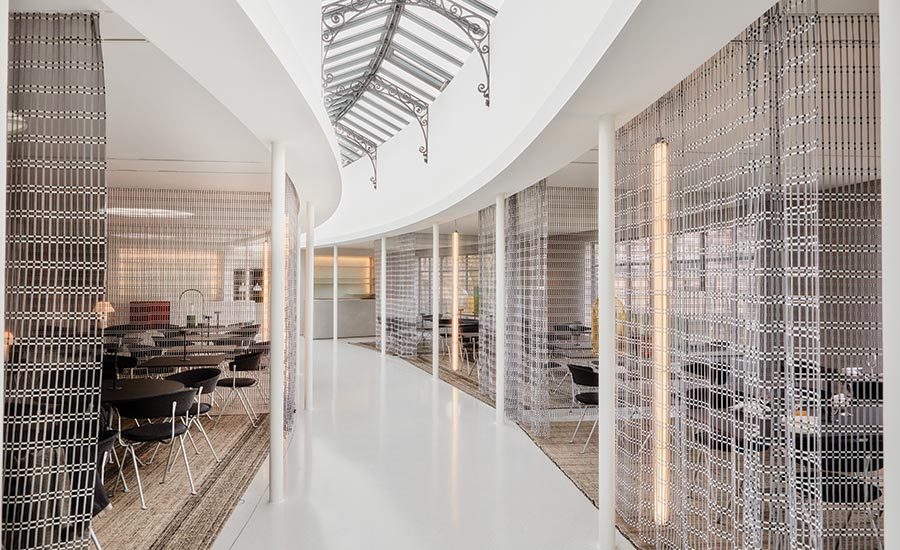
1
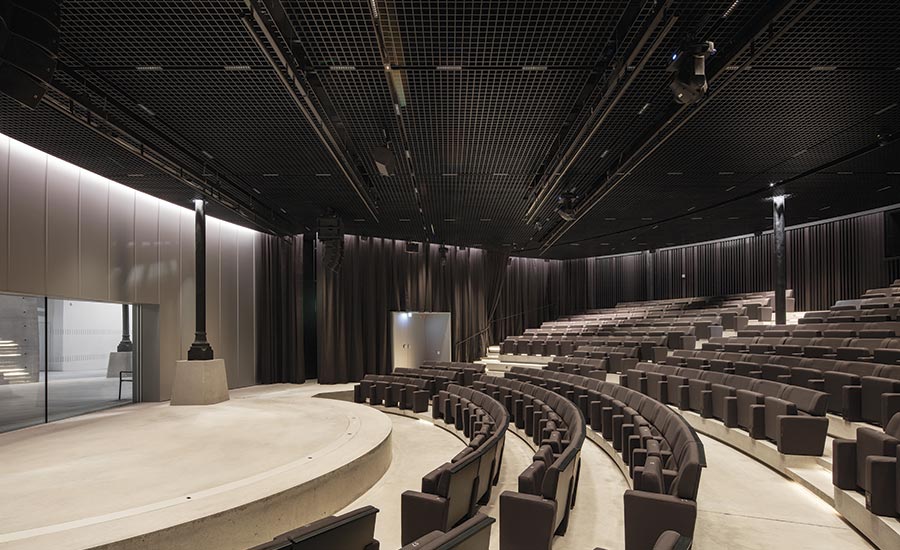
2
The top floor contains a restaurant (1) and the basement a theater that occupies half the cylinder (2). Photos © Maxime Tétard (1), Patrick Tourneboeuf (2)
Where the original fabric was concerned, “the building’s structure was a bit tired,” says Sancho, “so we had to repair and reinforce it to take museum-standard loads.” The basement’s floor was lowered about 3 feet, and a large technical area excavated below it. “Since time was tight, we had to do pretty much everything at once,” he continues. “As we were digging the lower basement, scaffolding was in place for work on the dome (the glass was changed and the canvas restored), the metal structure of the cylinder was going up, followed by the formwork, while, outside, the facades and roof were being restored.” In addition to the administrative headache posed by this simultaneity, there was the risk that a problem in just one sector would bring everything grinding to a halt. The complexity of the task saw to it that the empty building was delivered over a year and a half late—then Covid-19 delayed inauguration by another 12 months.
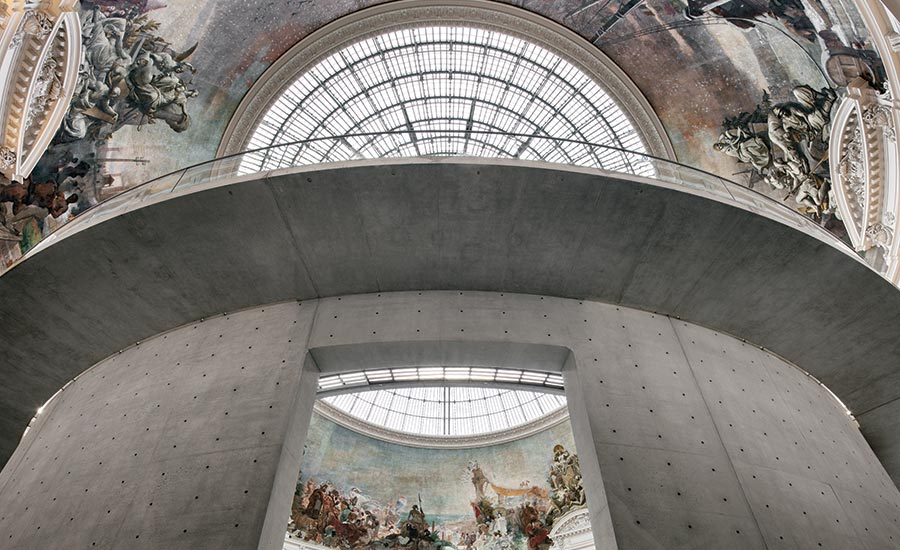
The glass of the dome was replaced and its painting restored. Photo © Patrick Tourneboeuf
Four years in the making (still extremely fast), the finished museum—complete with bespoke lighting and furnishings by French star designers Erwan and Ronan Bouroullec—does not disappoint: Ando and company have succeeded in pulling off the paradox, radically altering the building while ensuring that it still appears the same (hats off to Gatier’s restoration team). Were one inclined to gripe, it would merely be to regret the lack of surprise, for the Bourse delivers exactly what was promised on the can, no less, no more. Inevitably one is tempted to compare it to Paris’s other billionaire-built art museum, the Fondation Louis Vuitton dreamt up by Frank Gehry for French luxury-sector magnate Bernard Arnault. Though purpose-designed, Gehry’s overwrought building seems poorly adapted to the task of displaying art, with vast, overwhelming, ill-proportioned galleries and a museum circuit that defies all logic, sending visitors off on a wild goose chase in search of the next room in the sequence. Pinault’s museum, on the other hand, converted from an entirely unrelated and, a priori, incompatible function, provides an ideal range of spaces organized in an easily navigable manner, with a flexibility of layout that will allow it to remain open all year, segments being closeable for rehangs without disrupting visitor flow. Obviously, it helps to have a billionaire client ready to reach deep into his pockets (the official figure is $120 million, all told), though any extra spending at the Bourse had to be justified, and luxury was sought in the quality of execution rather than in ostentation of forms or materials. But then, they could afford understated good taste at the Bourse de Commerce, since Blondel’s railroad-age baroque offers all the required spectacle in spades, Ando’s cylinder adding a further dimension to the spatial thrill.
Click plans to enlarge
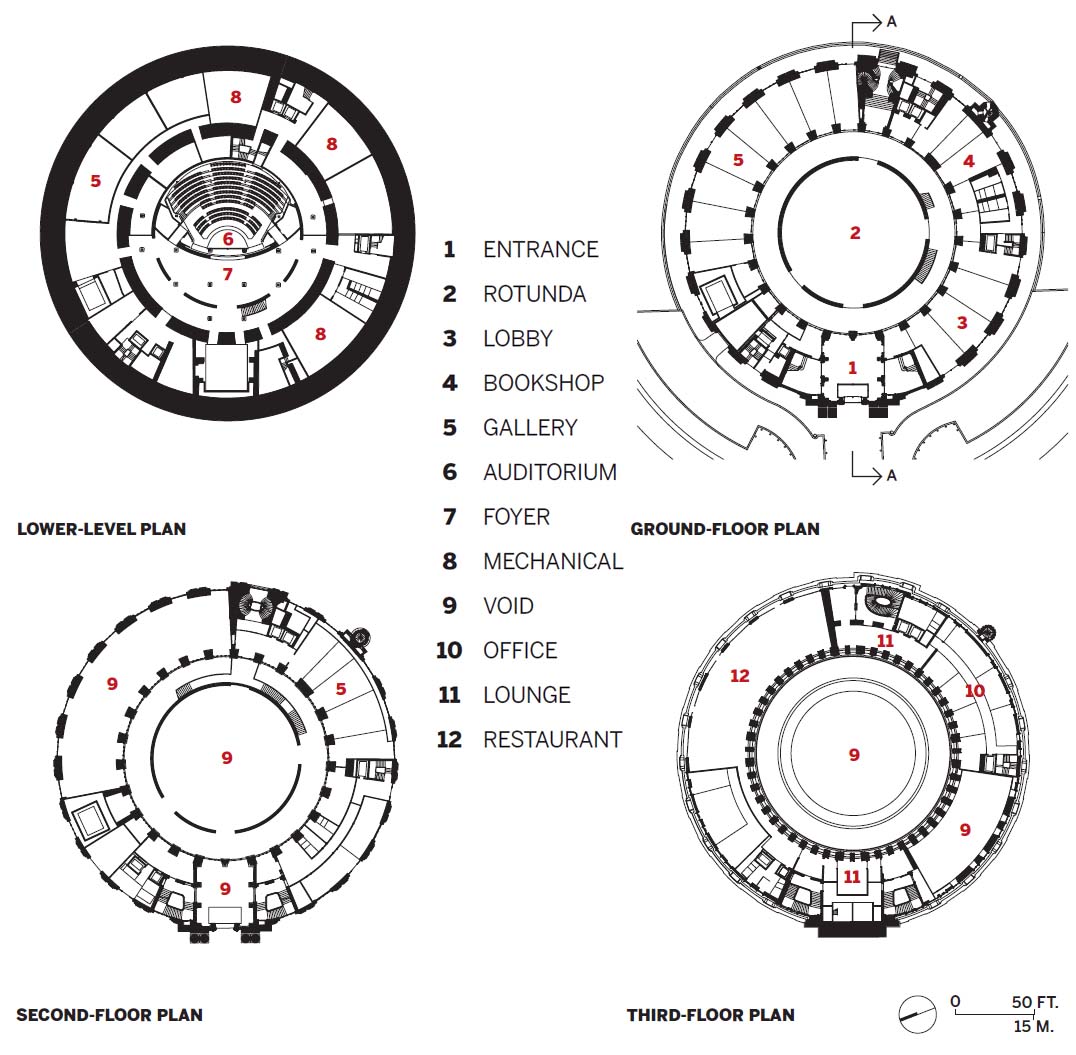
Click section to enlarge
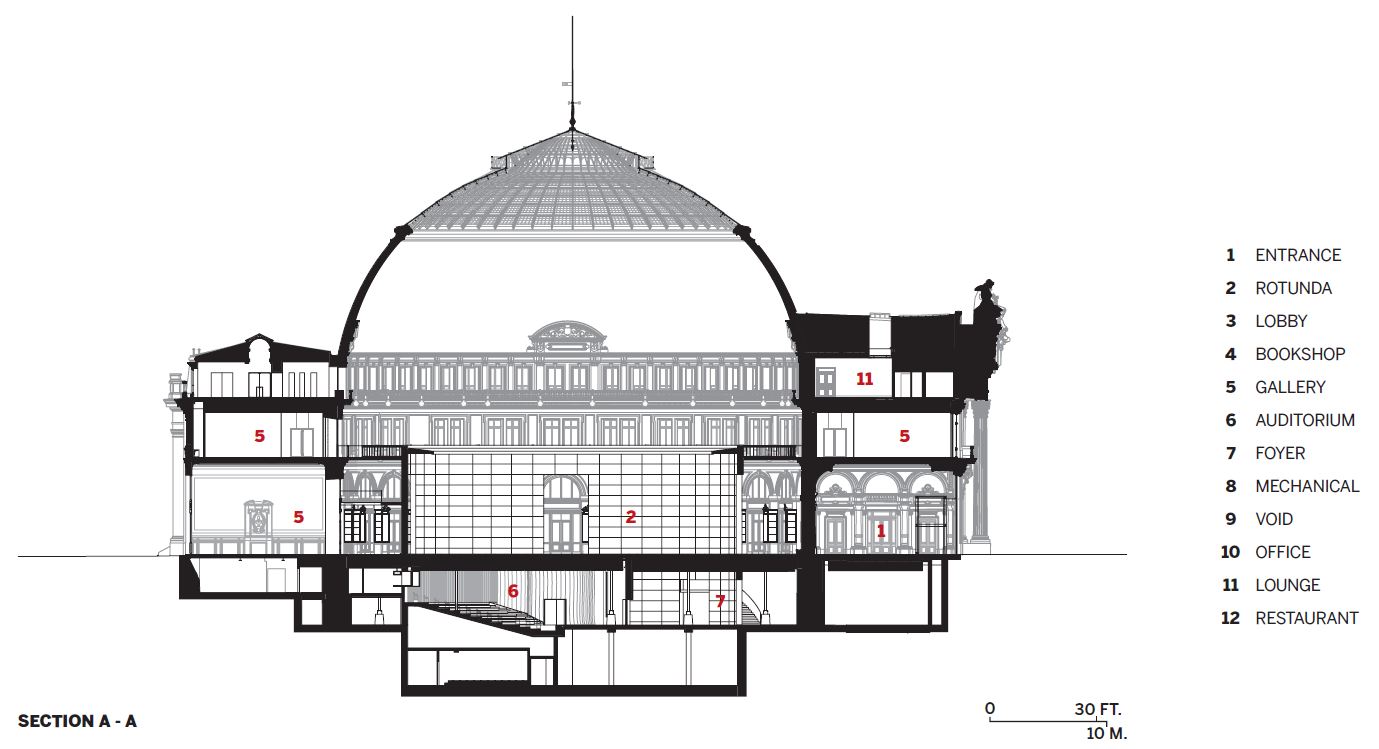
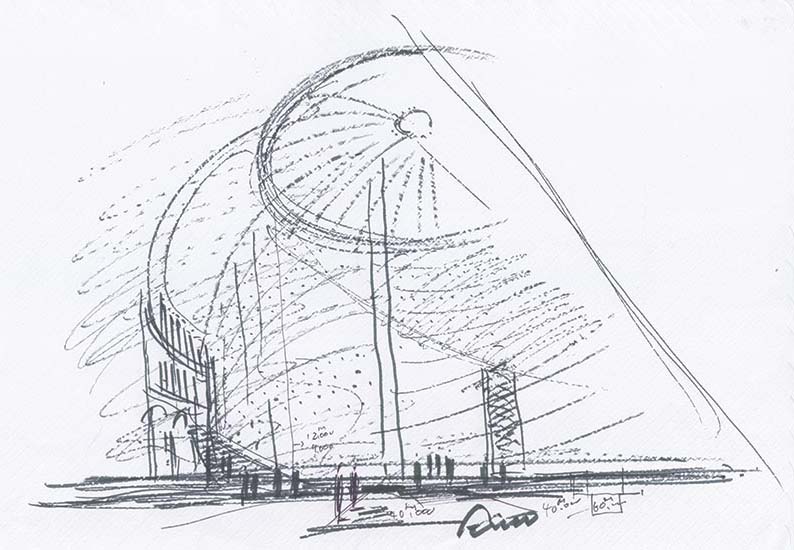
Credits
Architect:
Tadao Ando Architect & Associates
Associate Architect:
NeM / Niney et Marca Architectes
Engineer:
setec bâtiment
Consultants:
Agence Pierre-Antoine Gatier (preservation); T/E/S/S (glass dome)
General Contractor:
Bouygues Rénovation Privée
Client:
Collection Pinault Paris
Size:
107,500 square feet
Cost:
$120 million
Completion Date:
May 2021



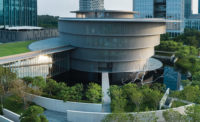
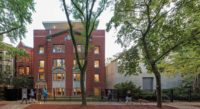

Post a comment to this article
Report Abusive Comment